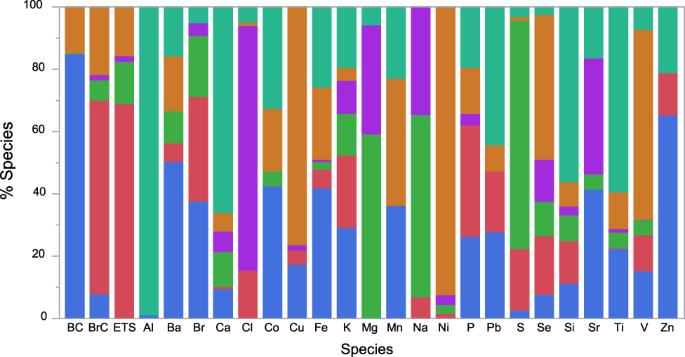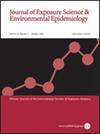Sources of personal PM2.5 exposure during pregnancy in the MADRES cohort
IF 4.1
3区 医学
Q2 ENVIRONMENTAL SCIENCES
Journal of Exposure Science and Environmental Epidemiology
Pub Date : 2024-02-07
DOI:10.1038/s41370-024-00648-z
引用次数: 0
Abstract
Personal exposure to fine particulate matter (PM2.5) is impacted by different sources each with different chemical composition. Determining these sources is important for reducing personal exposure and its health risks especially during pregnancy. Identify main sources and their contributions to the personal PM2.5 exposure in 213 women in the 3rd trimester of pregnancy in Los Angeles, CA. We measured 48-hr integrated personal PM2.5 exposure and analyzed filters for PM2.5 mass, elemental composition, and optical carbon fractions. We used the EPA Positive Matrix Factorization (PMF) model to resolve and quantify the major sources of personal PM2.5 exposure. We then investigated bivariate relationships between sources, time-activity patterns, and environmental exposures in activity spaces and residential neighborhoods to further understand sources. Mean personal PM2.5 mass concentration was 22.3 (SD = 16.6) μg/m3. Twenty-five species and PM2.5 mass were used in PMF with a final R2 of 0.48. We identified six sources (with major species in profiles and % contribution to PM2.5 mass) as follows: secondhand smoking (SHS) (brown carbon, environmental tobacco smoke; 65.3%), fuel oil (nickel, vanadium; 11.7%), crustal (aluminum, calcium, silicon; 11.5%), fresh sea salt (sodium, chlorine; 4.7%), aged sea salt (sodium, magnesium, sulfur; 4.3%), and traffic (black carbon, zinc; 2.6%). SHS was significantly greater in apartments compared to houses. Crustal source was correlated with more occupants in the household. Aged sea salt increased with temperature and outdoor ozone, while fresh sea salt was highest on days with westerly winds from the Pacific Ocean. Traffic was positively correlated with ambient NO2 and traffic-related NOx at residence. Overall, 76.8% of personal PM2.5 mass came from indoor or personal compared to outdoor sources. We conducted source apportionment of personal PM2.5 samples in pregnancy in Los Angeles, CA. Among identified sources, secondhand smoking contributed the most to the personal exposure. In addition, traffic, crustal, fuel oil, fresh and aged sea salt sources were also identified as main sources. Traffic sources contained markers of combustion and non-exhaust wear emissions. Crustal source was correlated with more occupants in the household. Aged sea salt source increased with temperature and outdoor ozone and fresh sea salt source was highest on days with westerly winds from the Pacific Ocean.

MADRES 队列中怀孕期间个人 PM2.5 暴露来源。
背景:个人接触细颗粒物(PM2.5)受不同来源的影响,每个来源的化学成分都不同。确定这些来源对于减少个人暴露及其健康风险(尤其是在怀孕期间)非常重要:目标:确定加利福尼亚州洛杉矶市 213 名怀孕三个月妇女个人 PM2.5 暴露的主要来源及其贡献:我们测量了 48 小时的个人 PM2.5 综合暴露量,并分析了过滤器中 PM2.5 的质量、元素组成和光学碳组分。我们使用美国环保署的正矩阵因式分解(PMF)模型来解析和量化个人 PM2.5 暴露的主要来源。然后,我们调查了来源、时间活动模式以及活动场所和住宅区环境暴露之间的双变量关系,以进一步了解来源:个人 PM2.5 平均浓度为 22.3(SD = 16.6)微克/立方米。在 PMF 中使用了 25 个物种和 PM2.5 质量,最终 R2 为 0.48。我们确定了以下六个来源(包括剖面中的主要物种和对PM2.5质量的贡献率):二手烟(SHS)(褐碳、环境烟草烟雾;65.3%)、燃油(镍、钒;11.7%)、地壳(铝、钙、硅;11.5%)、新鲜海盐(钠、氯;4.7%)、陈年海盐(钠、镁、硫;4.3%)和交通(黑碳、锌;2.6%)。公寓的 SHS 明显高于住宅。地壳源与住户数量相关。陈年海盐随着温度和室外臭氧的增加而增加,而新鲜海盐在太平洋吹西风的日子里含量最高。交通与居住地的环境二氧化氮和与交通相关的氮氧化物呈正相关。总体而言,与室外来源相比,76.8%的个人PM2.5来自室内或个人:我们对加利福尼亚州洛杉矶怀孕期间的个人 PM2.5 样本进行了来源分配。在已确定的来源中,二手烟对个人暴露的影响最大。此外,交通、地壳、燃油、新鲜和陈年海盐来源也被确定为主要来源。交通源含有燃烧和非废气磨损排放的标记。地壳源与住户人数较多有关。老化海盐源随着温度和室外臭氧的增加而增加,新鲜海盐源在太平洋吹西风的日子里最高。
本文章由计算机程序翻译,如有差异,请以英文原文为准。
求助全文
约1分钟内获得全文
求助全文
来源期刊
CiteScore
8.90
自引率
6.70%
发文量
93
审稿时长
3 months
期刊介绍:
Journal of Exposure Science and Environmental Epidemiology (JESEE) aims to be the premier and authoritative source of information on advances in exposure science for professionals in a wide range of environmental and public health disciplines.
JESEE publishes original peer-reviewed research presenting significant advances in exposure science and exposure analysis, including development and application of the latest technologies for measuring exposures, and innovative computational approaches for translating novel data streams to characterize and predict exposures. The types of papers published in the research section of JESEE are original research articles, translation studies, and correspondence. Reported results should further understanding of the relationship between environmental exposure and human health, describe evaluated novel exposure science tools, or demonstrate potential of exposure science to enable decisions and actions that promote and protect human health.

 求助内容:
求助内容: 应助结果提醒方式:
应助结果提醒方式:


